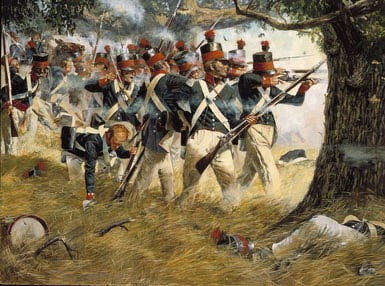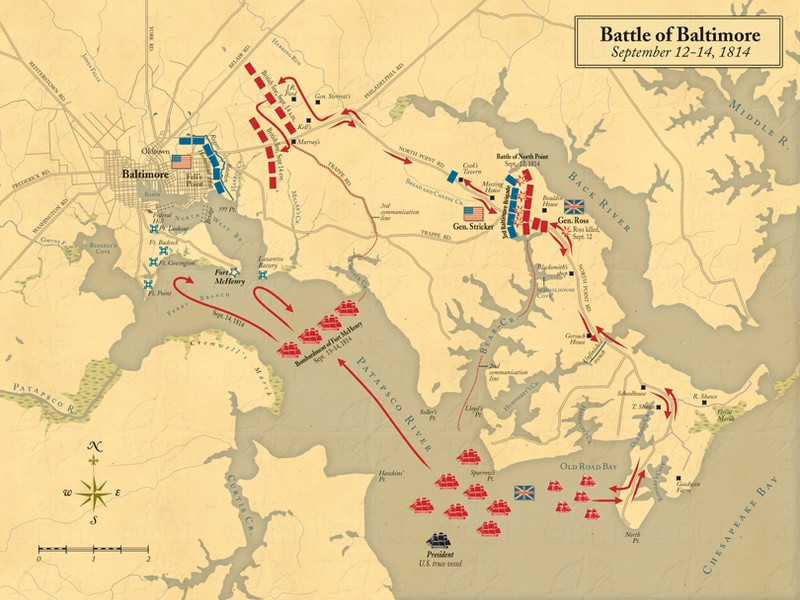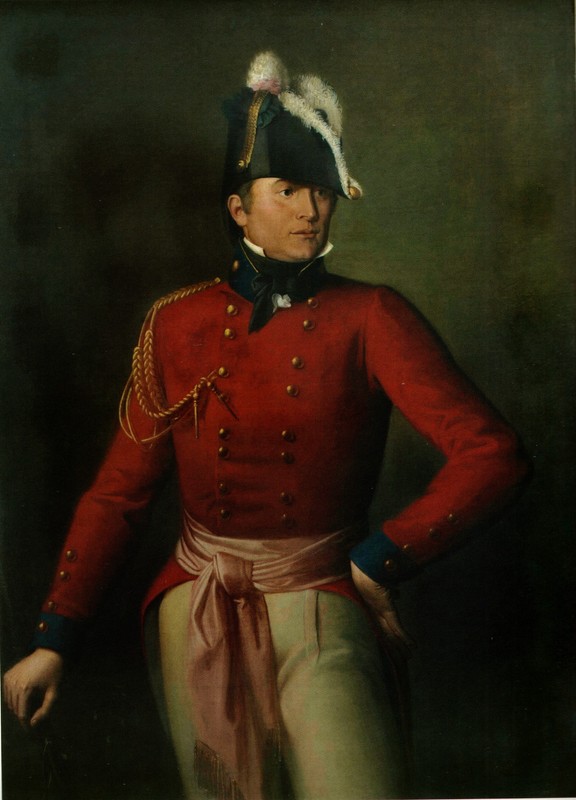Battle of North Point
Introduction
Text-to-speech Audio
Images
Battle of North Point by Don Troiani

Battle of North Point shown as part of the Battle of Baltimore

Major General Robert Ross, mortally wounded at the Battle of North Point

Backstory and Context
Text-to-speech Audio
By the autumn of 1814, the United States found itself mired it a terrible, sour war for which it bore responsibility. Angry over British depredations of American shipping on the high seas and British aid to Native Americans in the West, the United States declared war in the summer of 1812. Over the subsequent two years, the United States repeatedly failed to conquer Canada and suffered economic devastation at the hands of a British blockade.
The British blockade of the Chesapeake Bay in particular proved devastating. Initially confined to halting American commerce and raiding small Chesapeake communities, by 1814 the British were ready for something bigger. Having defeated Napoleonic France (at least temporarily), Britain sent reinforcements to the Chesapeake Bay. In August 1814, a British army commanded by Major General Robert Ross marched on Washington, D.C. (defeating an American army at Bladensburg, MD in route) and burned the nation’s capital.
Following the sacking of Washington, the British looked to Baltimore as their next target. One of America’s major seaports, home to many privateers, and its third largest city, the British believed “this town must be laid in ashes.”[3] Yet Baltimore would not be easy to crack. Since the start of the blockade, Baltimore invested heavily in its city defenses. U.S. Senator and Maryland militia Major General Samuel Smith (a veteran of the Revolution) supervised the construction of extensive fortifications around the city, including garrisoning Fort McHenry overlooking the city harbor and building powerful redoubts to protect the city’s eastern land approaches. These fortifications were funded by the city and built by its inhabitants, both free and enslaved. To man the defenses, nearly 10,000 men guarded the city, mostly militia from Maryland, Pennsylvania, and Virginia, as well as a small force of U.S. Army regulars.
To take Baltimore, the British planned a two-prong attack advancing over land at North Point and attacking harbor defenses by sea at Fort McHenry. In the early hours of September 12, 1814, General Ross disembarked near North Point, Maryland with 4,700 men and advanced towards Baltimore. Yet the road from North Point to Baltimore was guarded by a brigade of 3,200 Maryland militia under General John Strickler. Stricker’s men were positioned in a layered defense near North Point, with cavalry scouts keeping Stricker abreast of British movements. General Ross proved undeterred by the American defenses: “I don’t care if it rains militia.”[3]
As the British advanced, American skirmishers opened fire. Although only a delaying tactic, one American rifleman managed to mortally wound General Ross. The battle barely begun, command fell to Colonel Brooke, who promptly ordered an attack on the American position. In particular, Brooke ordered his men to exploit a gap on the American left flank. The Americans offered a terrible resistance, particularly on their right flank, but the left eventually crumbled. The Marylanders retreated several miles towards Baltimore in good order, taking up a position in the city’s fortifications. The British claimed victory at the Battle of North Point.
During the battle, the Americans lost 163 killed and wounded with 200 captured as compared to the British casualties of 46 killed and 273 wounded. While a tactical defeat, the Battle of North Point proved a strategic victory for the Americans. The battle allowed Major General Samuel Smith to complete his preparations for defending the city. In the subsequent Battle of Baltimore, both the British land and naval assaults were repulsed by the American forces, sparing the city Washington’s fate (and giving rise to the U.S. national anthem).
Today nine acres of the battlefield are preserved and interpreted as Maryland’s North Point State Battlefield (nearby North Point State Park also preserves ground relevant to the campaign). Every year, Maryland commemorates the successful defense of Baltimore via the Defenders’ Day state holiday in mid-September.
Sources
1. Allison, William T., Jeffrey Grey, and Janet G. Valentine. American Military History: A Survey from Colonial Times to the Present. Upper Saddle River, NJ: Pearson Education, Inc., 2007.
2. James Clifford. "Battles That Saved America: North Point and Baltimore 1814." National Museum, United States Army. Web. https://armyhistory.org/battles-that-saved-america-north-point-and-baltimore-1814/
3. Charles P. Neimeyer. The Chesapeake Campaign, 1813-1814. Washington, D.C.: Center of Military History, United States Army, 2014.
4. Stanley L. Quick and Chipp Reid. Lion in the Bay: The British Invasion of the Chesapeake, 1813-1814. Annapolis, MD: Naval Institute Press, 2015.
5. Robert Gleig. A Narrative of the Campaigns of the British Army at Washington and New Orleans. London: John Murray, 1821.
Smithsonian Institution via the NPS: https://www.nps.gov/people/robert-ross.htm
